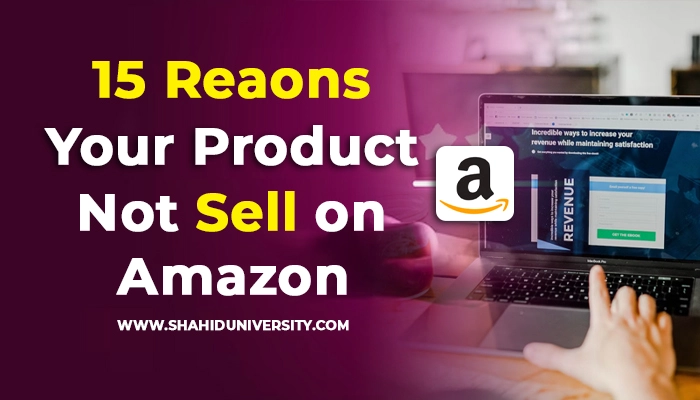Introduction
Selling your products on Amazon, which is one of the world’s largest and highly competitive online marketplaces, can be a lucrative venture. Nevertheless, numerous sellers face a common and vexing issue – their products don’t sell as well as anticipated. If you find yourself in this predicament, you’re not alone.
The causes of slow sales on Amazon can be intricate and multifaceted, but comprehending them marks the initial step in your quest to reverse the situation in your favor. This article is intended to illuminate the various factors that might be contributing to your product’s lackluster performance on Amazon, and it offers valuable insights and strategies to tackle these challenges.
Whether it involves optimizing your product listings, establishing trust with customers, refining your pricing strategy, or enhancing your product presentation, we will delve into these obstacles and provide practical solutions to assist you in increasing your sales and achieving success on the Amazon platform.
Understanding Amazon’s Algorithm
1. The Importance of Amazon SEO (Search Engine Optimization)
Amazon SEO, also known as Search Engine Optimization for Amazon, is crucial for achieving success with your products on the platform. It involves the skill of enhancing your product listings to achieve higher rankings in Amazon’s search results, thus making your products more noticeable to potential buyers. This is achieved by carefully choosing relevant keywords, crafting compelling product titles and descriptions, and ensuring the quality of your product images is top-notch. By doing so, you enhance your chances of attracting organic traffic.
Similar to other search engines, Amazon’s algorithm rewards products that offer an excellent shopping experience for customers. When your product listing is optimized for SEO, it is more likely to match customer search queries, resulting in increased visibility, higher click-through rates, and ultimately, more sales. In the competitive world of e-commerce, mastering Amazon SEO is the key to achieving success.
2. Poor Keyword Selection
In your Amazon sales endeavor, inadequate keyword selection can pose a significant obstacle. When picking keywords, it’s vital to find the right balance between relevance and competitiveness. Opting for excessively broad keywords can result in your product being lost in a crowded market, while overly specific ones may not attract sufficient search traffic.
Furthermore, neglecting long-tail keywords, which are typically less competitive and more precise, can restrict your product’s chances of being discovered. It’s crucial to conduct thorough research and opt for keywords that match your product, have reasonable search volume, and can connect you with your desired audience. Failing to address this aspect can result in reduced visibility and lackluster sales performance on Amazon.
3. Neglecting Product Titles and Descriptions
Neglecting the importance of product titles and descriptions can prove to be a significant mistake in your Amazon sales strategy. These elements serve as the online equivalent of your store’s front window, and a poorly constructed title or description can discourage potential customers. A vague and uninformative title fails to effectively communicate your product’s value and purpose.
Similarly, a lackluster product description doesn’t captivate or convince potential buyers. To steer clear of this pitfall, make sure your product title is succinct yet descriptive, incorporating essential keywords for improved search optimization. Craft a comprehensive and compelling product description that showcases the product’s features, advantages, and possible uses. Keep in mind that a well-crafted title and description not only boost your product’s visibility but also weave a more engaging story, thereby increasing the chances of turning visitors into customers.
3. Lack of Customer Trust
A key factor that could be preventing your product from selling successfully on Amazon is the absence of customer trust. Trust plays a critical role in the world of e-commerce, and there are various elements that can undermine it. For instance, when there are limited or unfavorable reviews, it acts as a major deterrent because prospective buyers heavily rely on the experiences shared by others.
When reviews are scarce or mostly negative, it raises concerns about the quality of your product. Additionally, failing to respond to customer questions can make your product seem less dependable, potentially discouraging potential buyers. To establish and enhance trust, it’s important to encourage customers to share their feedback, promptly address inquiries, and provide exceptional customer service. Building trust is a fundamental aspect of achieving success in your sales endeavors on Amazon.
4. Sparse or Negative Reviews
Unfavorable evaluations can wield a substantial influence on the reputation and sales of your product. These critical remarks, often arising from unsatisfied customers, have the potential to dissuade prospective buyers and undermine trust. It is essential to approach negative reviews with caution and professionalism. Respond to them in a timely manner, addressing concerns and providing solutions when feasible.
Encourage constructive input and seize the chance to enhance your product or service based on valid criticisms. Keep in mind that a combination of positive and negative reviews can actually bolster your product’s credibility, demonstrating transparency and authenticity. Use negative feedback as a stepping stone for growth and improvement, rather than viewing it as an obstacle to success on platforms like Amazon.
5. Unanswered Customer Questions
Unaddressed inquiries from customers on Amazon may discourage potential buyers and impede the success of your product. When customers ask questions about your product, they are typically looking for more details to help them make an informed purchase choice. When these inquiries go without replies, it can lead to uncertainty and a decline in trust.
To effectively tackle this issue, regularly monitor your product listings for customer questions. Make sure to provide accurate and helpful responses promptly. By doing so, you not only aid potential customers but also showcase your dedication to customer satisfaction, which can bolster your product’s reputation and boost the likelihood of making sales.
6. Pricing Mistakes
Effective pricing plays a crucial role in achieving success on Amazon. Setting your prices too high can discourage potential buyers, prompting them to seek better deals elsewhere. When a product is seen as overly expensive, it can result in lackluster sales and limited profitability. Conversely, if you price your product too low, you may attract buyers, but it can create the impression of lower quality, which can negatively impact your revenue and brand reputation.
Striking the right balance is essential. It involves researching competitor pricing, considering your costs, and understanding the expectations of your target audience. It’s also important to regularly review and adjust your prices to remain competitive, ensuring that your pricing strategy aligns with your product’s perceived value and the dynamics of the market.
7. Overpricing
Setting a price that’s too high is a common mistake that can significantly impede the success of your product on Amazon. When your price is excessively elevated, it may discourage potential customers from making a purchase, as they might believe your product is overpriced when compared to similar options from competitors.
This overpricing can result in higher rates of abandoned shopping carts and decreased conversion rates, ultimately leading to reduced sales and revenue. To avoid this problem, it’s crucial to conduct comprehensive market research to establish a price point that is both competitive and profitable for your product. Striking the right balance between value and cost is essential for attracting and retaining customers, ultimately driving sales and achieving success on the Amazon platform.
8. Underpricing
Setting a lower price for your product on Amazon comes with pros and cons. On one hand, it may initially attract price-conscious shoppers, but on the other hand, it can give rise to various challenges. One significant concern is that potential buyers could interpret your product as being of lower quality because of its affordable cost. This has the potential to undermine trust and credibility in the long term.
Furthermore, underpricing might negatively impact your profitability and impede your ability to cover expenses such as Amazon fees and shipping costs. To address this problem, it’s crucial to conduct comprehensive market research, have a clear understanding of your production costs, and find a balance between offering competitive prices while ensuring that consumers perceive your product as valuable.
9. Poor Product Images
In the world of online shopping, one cannot overemphasize the significance of product images. Insufficient product visuals can quietly undermine your sales efforts, driving potential customers to explore other options. When your images lack quality, appear blurry, or lack a professional touch, they fall short of presenting your product in its best possible way. This can lead customers to question the product’s overall quality and dependability.
Furthermore, a lack of image diversity, such as failing to display various angles or unique features, can leave potential buyers in the dark. To thrive on platforms like Amazon, it’s essential to invest in top-notch, crystal-clear, and captivating product images. They serve as the initial visual representation of your product, and ensuring it leaves a positive impression is critical for achieving sales success.
10. Low-Quality Images
In the realm of Amazon, the presence of low-quality images can pose a significant obstacle to your product’s prosperity. When your product visuals lack clarity, intricate details, or a professional touch, they can discourage potential buyers from completing a purchase. Fuzzy, pixelated, or poorly composed photographs fall short in showcasing your product’s attributes and can generate doubt regarding its quality.
In the visually-oriented landscape of online marketplaces, these subpar images can convey an image of an unprofessional and untrustworthy seller, prompting customers to explore alternative choices. To enhance the prospects of your product selling effectively on Amazon, it is imperative to make an investment in high-quality, well-illuminated, and professionally crafted visuals. This investment has the potential to yield substantial returns in the form of increased sales and enhanced customer confidence.
11. Insufficient Image Variety
Having a diverse collection of high-quality pictures is crucial when you’re selling your products on Amazon. Inadequate image variety, be it a shortage of different viewpoints, close-up shots, or images that highlight various product attributes, can discourage potential buyers. When customers can’t examine your product from various angles or grasp its features, they might hesitate to complete a purchase.
Offering a range of images not only boosts customer confidence but also assists them in visualizing how the product can integrate into their lives. This is a fundamental aspect of your product listing that should not be underestimated. In the fiercely competitive Amazon marketplace, a variety of captivating images can make your product stand out.
12. Shipping and Fulfillment Issues
Problems with shipping and order fulfillment can significantly hinder the success of your Amazon business. Prolonged delivery times may cause potential customers to abandon their shopping carts, as they increasingly expect prompt deliveries. To avoid this issue, it’s advisable to optimize your supply chain and explore faster shipping alternatives.
Inadequate packaging poses another concern, as subpar packaging can lead to product damage during shipping, resulting in returns, negative reviews, and a damaged reputation. Make sure that your products are well-protected and professionally presented to minimize the risk of damage during transit and the associated challenges. By addressing these issues, you can enhance customer satisfaction and enhance your prospects for achieving successful sales on Amazon.
13. Lengthy Shipping Times
Extended delivery times can act as a significant discouragement for individuals who shop online. In a time when people typically expect instant gratification, having to wait for an extended period for a product to reach them can result in customers abandoning their shopping carts and feeling dissatisfied. These prolonged shipping durations not only diminish the overall quality of the shopping experience but can also negatively impact the reputation of the seller.
Customers often anticipate swift deliveries and are more inclined to choose vendors who offer faster shipping choices. Therefore, it is crucial for e-commerce businesses to streamline their shipping and order fulfillment procedures to ensure that products are delivered promptly to customers, thereby meeting their expectations and enhancing overall customer satisfaction.
14. Lack of Marketing Efforts
Insufficient marketing endeavors can pose a major obstacle to achieving success on Amazon. Within a vast and fiercely competitive marketplace, the failure to effectively promote your product may result in it becoming lost among numerous others. Without well-targeted advertising and marketing campaigns, potential customers might never come across your product.
To address this challenge, it’s vital to invest in Amazon advertising, make use of social media marketing, and explore alternative promotional channels. Through active engagement with your audience and spreading the word about your product, you can enhance its visibility and ultimately boost sales. Marketing plays a crucial role in cutting through the clutter and making your product stand out.
15. Lengthy Shipping Times
Extended shipping durations in the realm of e-commerce and online retail pertain to the prolonged period it takes for a purchased product to arrive at the customer’s doorstep. This delay has the potential to irk customers, resulting in cart abandonment and negative feedback. The protracted shipping times may arise due to a variety of factors, such as inefficient logistics, delays in customs clearance, or the selection of slower shipping methods. In today’s fast-paced consumer landscape where swift deliveries are the standard, lengthy shipping times can serve as a considerable deterrent to prospective buyers. To stay competitive and maintain high customer satisfaction levels, businesses must concentrate on streamlining their shipping processes and providing expedited shipping options whenever feasible.
Conclusion
In summary, achieving successful sales for your product on Amazon necessitates a comprehensive strategy that takes into account several factors that impact its performance. Central to your approach should be Amazon’s algorithm, which places a heavy emphasis on SEO. It is crucial to prioritize tasks such as selecting the right keywords, optimizing product titles, and crafting engaging product descriptions to boost visibility.
Equally vital is the establishment of trust with customers. This involves garnering positive reviews and promptly addressing customer inquiries, as these factors play a pivotal role. Properly pricing your product, showcasing it with high-quality images, and ensuring efficient shipping and packaging also need careful consideration.
Furthermore, surpassing your competition and actively engaging in marketing efforts can help your product stand out in the expansive Amazon marketplace. By recognizing and addressing these challenges, you can pave the way for increased sales and a more prominent presence on Amazon, ultimately transforming your product into a success story on this dynamic e-commerce platform.
Frequently Asked Questions
-
How long does it take for Amazon SEO efforts to yield results?
Amazon SEO efforts can take some time to yield results, often several weeks to months. It’s crucial to be patient and consistent in your optimization strategies.
-
What’s the best way to encourage positive customer reviews on Amazon?
Provide excellent customer service, a high-quality product, and actively request reviews from satisfied customers. Remember to follow Amazon’s review policies.
-
Can I change my product’s pricing strategy on Amazon?
Yes, you can adjust your product’s pricing strategy at any time. Just be mindful of how price changes can affect your product’s performance and customer perception.
-
How can I effectively differentiate my product in a competitive niche on Amazon?
Consider adding unique features, bundling complementary items, or focusing on exceptional customer service to stand out in a competitive niche.
-
Is it necessary to use Amazon advertising to boost sales?
While it’s not mandatory, using Amazon advertising can significantly increase your product’s visibility and sales on the platform. It’s worth considering as part of your marketing strategy.








